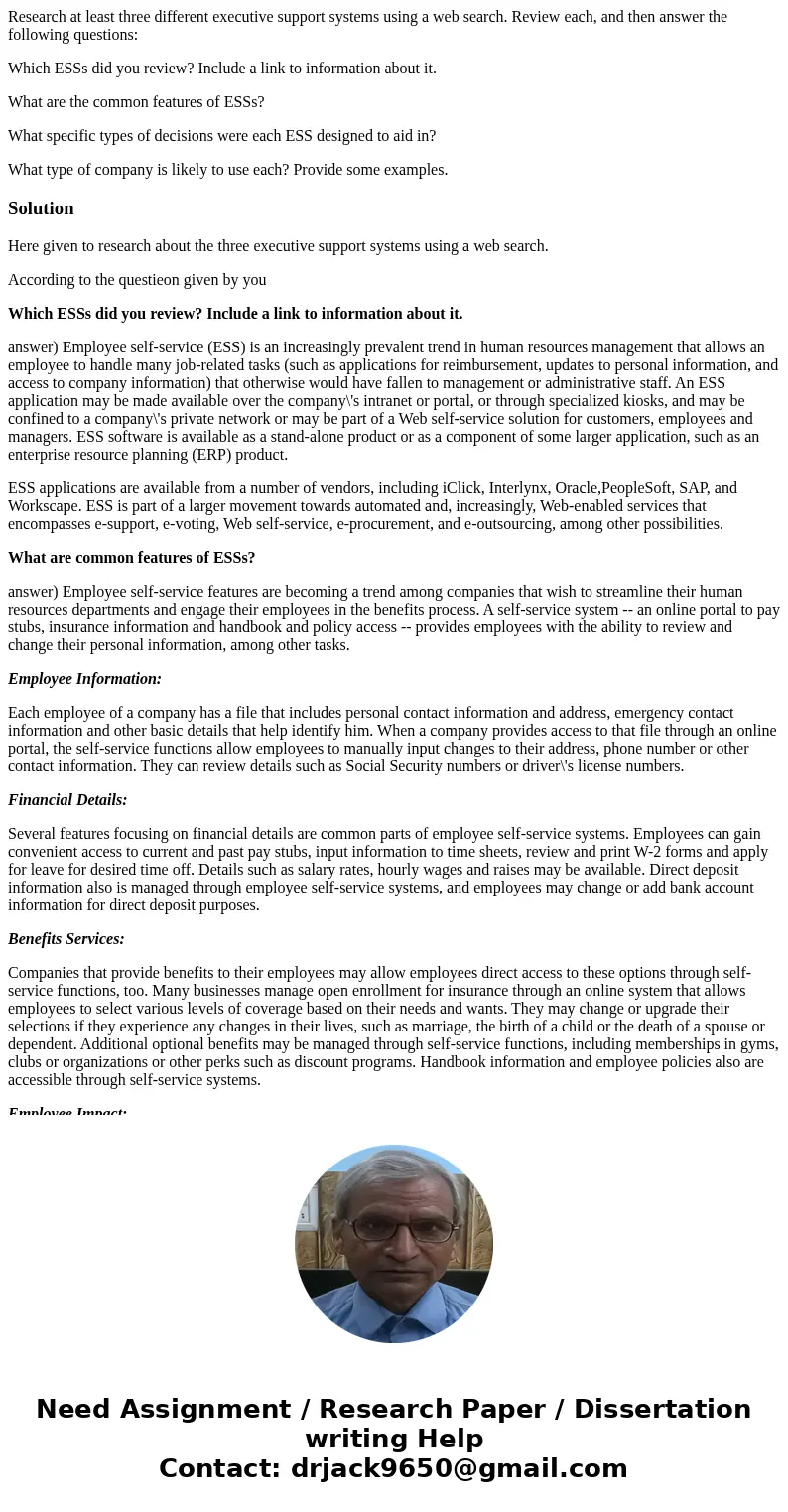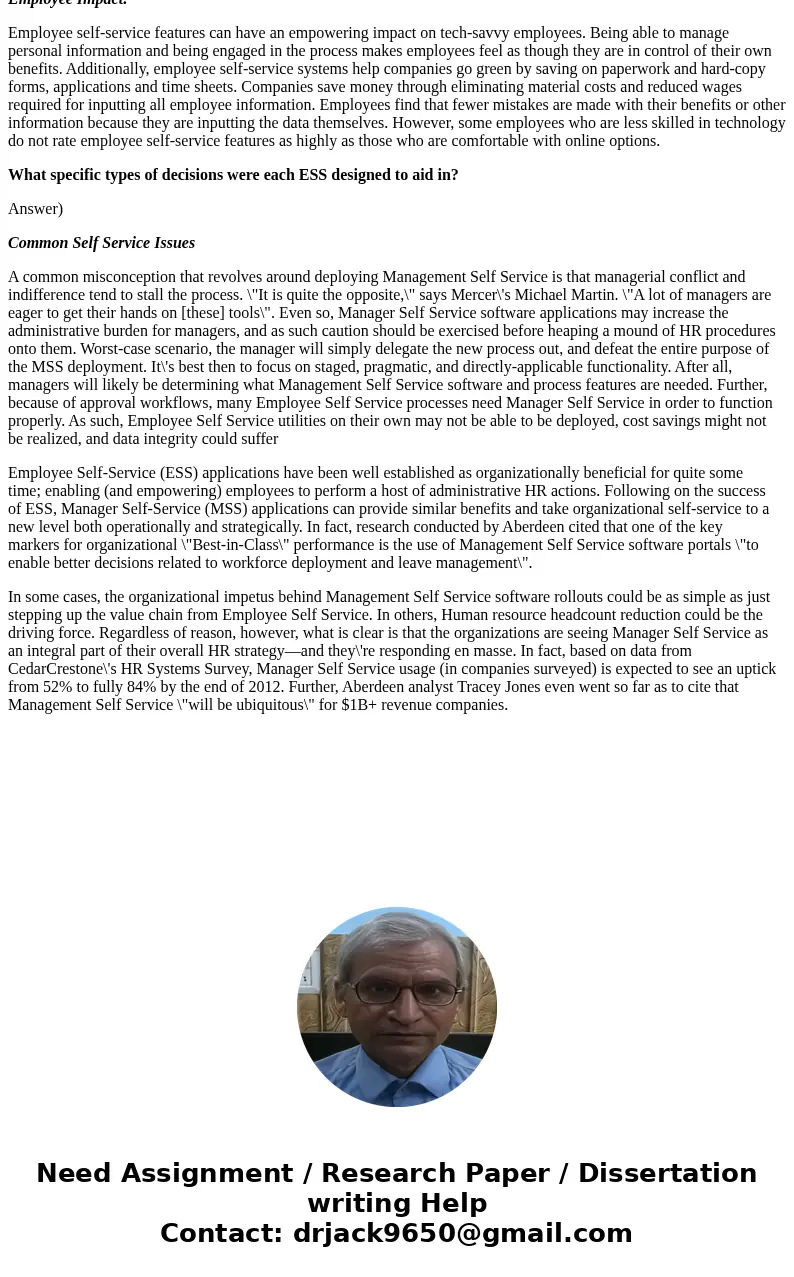Research at least three different executive support systems
Research at least three different executive support systems using a web search. Review each, and then answer the following questions:
Which ESSs did you review? Include a link to information about it.
What are the common features of ESSs?
What specific types of decisions were each ESS designed to aid in?
What type of company is likely to use each? Provide some examples.
Solution
Here given to research about the three executive support systems using a web search.
According to the questieon given by you
Which ESSs did you review? Include a link to information about it.
answer) Employee self-service (ESS) is an increasingly prevalent trend in human resources management that allows an employee to handle many job-related tasks (such as applications for reimbursement, updates to personal information, and access to company information) that otherwise would have fallen to management or administrative staff. An ESS application may be made available over the company\'s intranet or portal, or through specialized kiosks, and may be confined to a company\'s private network or may be part of a Web self-service solution for customers, employees and managers. ESS software is available as a stand-alone product or as a component of some larger application, such as an enterprise resource planning (ERP) product.
ESS applications are available from a number of vendors, including iClick, Interlynx, Oracle,PeopleSoft, SAP, and Workscape. ESS is part of a larger movement towards automated and, increasingly, Web-enabled services that encompasses e-support, e-voting, Web self-service, e-procurement, and e-outsourcing, among other possibilities.
What are common features of ESSs?
answer) Employee self-service features are becoming a trend among companies that wish to streamline their human resources departments and engage their employees in the benefits process. A self-service system -- an online portal to pay stubs, insurance information and handbook and policy access -- provides employees with the ability to review and change their personal information, among other tasks.
Employee Information:
Each employee of a company has a file that includes personal contact information and address, emergency contact information and other basic details that help identify him. When a company provides access to that file through an online portal, the self-service functions allow employees to manually input changes to their address, phone number or other contact information. They can review details such as Social Security numbers or driver\'s license numbers.
Financial Details:
Several features focusing on financial details are common parts of employee self-service systems. Employees can gain convenient access to current and past pay stubs, input information to time sheets, review and print W-2 forms and apply for leave for desired time off. Details such as salary rates, hourly wages and raises may be available. Direct deposit information also is managed through employee self-service systems, and employees may change or add bank account information for direct deposit purposes.
Benefits Services:
Companies that provide benefits to their employees may allow employees direct access to these options through self-service functions, too. Many businesses manage open enrollment for insurance through an online system that allows employees to select various levels of coverage based on their needs and wants. They may change or upgrade their selections if they experience any changes in their lives, such as marriage, the birth of a child or the death of a spouse or dependent. Additional optional benefits may be managed through self-service functions, including memberships in gyms, clubs or organizations or other perks such as discount programs. Handbook information and employee policies also are accessible through self-service systems.
Employee Impact:
Employee self-service features can have an empowering impact on tech-savvy employees. Being able to manage personal information and being engaged in the process makes employees feel as though they are in control of their own benefits. Additionally, employee self-service systems help companies go green by saving on paperwork and hard-copy forms, applications and time sheets. Companies save money through eliminating material costs and reduced wages required for inputting all employee information. Employees find that fewer mistakes are made with their benefits or other information because they are inputting the data themselves. However, some employees who are less skilled in technology do not rate employee self-service features as highly as those who are comfortable with online options.
What specific types of decisions were each ESS designed to aid in?
Answer)
Common Self Service Issues
A common misconception that revolves around deploying Management Self Service is that managerial conflict and indifference tend to stall the process. \"It is quite the opposite,\" says Mercer\'s Michael Martin. \"A lot of managers are eager to get their hands on [these] tools\". Even so, Manager Self Service software applications may increase the administrative burden for managers, and as such caution should be exercised before heaping a mound of HR procedures onto them. Worst-case scenario, the manager will simply delegate the new process out, and defeat the entire purpose of the MSS deployment. It\'s best then to focus on staged, pragmatic, and directly-applicable functionality. After all, managers will likely be determining what Management Self Service software and process features are needed. Further, because of approval workflows, many Employee Self Service processes need Manager Self Service in order to function properly. As such, Employee Self Service utilities on their own may not be able to be deployed, cost savings might not be realized, and data integrity could suffer
Employee Self-Service (ESS) applications have been well established as organizationally beneficial for quite some time; enabling (and empowering) employees to perform a host of administrative HR actions. Following on the success of ESS, Manager Self-Service (MSS) applications can provide similar benefits and take organizational self-service to a new level both operationally and strategically. In fact, research conducted by Aberdeen cited that one of the key markers for organizational \"Best-in-Class\" performance is the use of Management Self Service software portals \"to enable better decisions related to workforce deployment and leave management\".
In some cases, the organizational impetus behind Management Self Service software rollouts could be as simple as just stepping up the value chain from Employee Self Service. In others, Human resource headcount reduction could be the driving force. Regardless of reason, however, what is clear is that the organizations are seeing Manager Self Service as an integral part of their overall HR strategy—and they\'re responding en masse. In fact, based on data from CedarCrestone\'s HR Systems Survey, Manager Self Service usage (in companies surveyed) is expected to see an uptick from 52% to fully 84% by the end of 2012. Further, Aberdeen analyst Tracey Jones even went so far as to cite that Management Self Service \"will be ubiquitous\" for $1B+ revenue companies.


 Homework Sourse
Homework Sourse